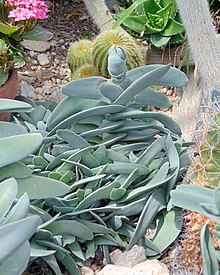| Crassulaceae | |
|---|---|

| |
| Crassula perfoliata Type species | |
| Scientific classification | |
| Kingdom: | Plantae |
| Clade: | Tracheophytes |
| Clade: | Angiosperms |
| Clade: | Eudicots |
| Order: | Saxifragales |
| Family: | Crassulaceae J.St.-Hil.[1] |
| Type genus | |
| Crassula | |
| Subfamilies | |
| |
| Synonyms | |
|
Sempervivae [Sempervivaceae] Jussieu[2] | |
The Crassulaceae (/ˈkræsjuːleɪsiːˌiː, -siˌaɪ/, from Latin crassus, thick), also known as the stonecrop family or the orpine family, are a diverse family of dicotyledon flowering plants characterized by succulent leaves and a unique form of photosynthesis, known as Crassulacean acid metabolism (CAM). Flowers generally have five floral parts. Crassulaceae are usually herbaceous but there are some subshrubs, and relatively few treelike or aquatic plants. Crassulaceae are a medium-sized monophyletic family in the core eudicots, among the order Saxifragales, whose diversity has made infrafamilial classification very difficult. The family includes approximately 1,400 species and 34–35 genera, depending on the circumscription of the genus Sedum, and distributed over three subfamilies. Members of the Crassulaceae are found worldwide, but mostly in the Northern Hemisphere and southern Africa, typically in dry and/or cold areas where water may be scarce, although a few are aquatic.
Crassulaceae are mainly perennial and have huge economic importance, internationally, as collectible, indoor and garden plants. Many species in the family have a bizarre, alien and intriguing appearance, with interesting textures, growths or even "furry" coverings, and are quite hardy, typically needing only minimal care. Still, many others have a more typical, "conventional" rosette form, something reflected in many common names, such as 'black rose' often referring to Aeonium arboreum var. 'Swartzkopf' or var. 'Merlot'. Well-known genera and species include the many forms of Crassula ovata ('jade plant', 'money plant' or 'friendship tree'), Kalanchoe blossfeldiana (florists' or supermarket-kalanchoe); Cotyledon, such as 'Chalk Fingers' and 'Pig's Ear', Sempervivum such as cobweb houseleek (or hen-and-chicks) and S. calcareum, and Aeonium such as A. haworthii (and its popular variegate 'Kiwi'), A. arboreum, canariense, urbicum; Monanthes, Umbilicus (pennywort), Bryophyllum, Echeveria, Sedum and Dudleya.